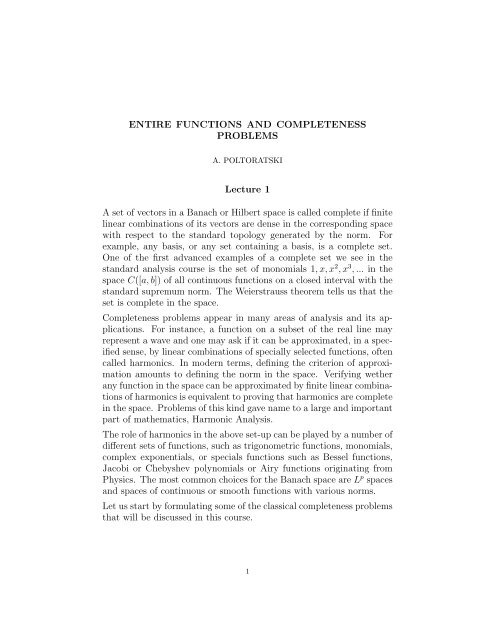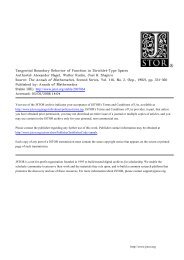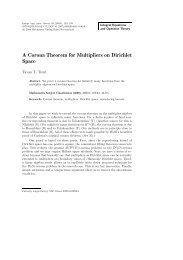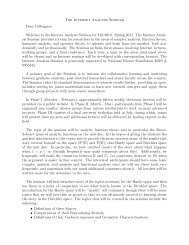Lecture 1 - Internet Analysis Seminar
Lecture 1 - Internet Analysis Seminar
Lecture 1 - Internet Analysis Seminar
You also want an ePaper? Increase the reach of your titles
YUMPU automatically turns print PDFs into web optimized ePapers that Google loves.
ENTIRE FUNCTIONS AND COMPLETENESS<br />
PROBLEMS<br />
A. POLTORATSKI<br />
<strong>Lecture</strong> 1<br />
A set of vectors in a Banach or Hilbert space is called complete if finite<br />
linear combinations of its vectors are dense in the corresponding space<br />
with respect to the standard topology generated by the norm. For<br />
example, any basis, or any set containing a basis, is a complete set.<br />
One of the first advanced examples of a complete set we see in the<br />
standard analysis course is the set of monomials 1, x, x 2 , x 3 , ... in the<br />
space C([a, b]) of all continuous functions on a closed interval with the<br />
standard supremum norm. The Weierstrauss theorem tells us that the<br />
set is complete in the space.<br />
Completeness problems appear in many areas of analysis and its applications.<br />
For instance, a function on a subset of the real line may<br />
represent a wave and one may ask if it can be approximated, in a specified<br />
sense, by linear combinations of specially selected functions, often<br />
called harmonics. In modern terms, defining the criterion of approximation<br />
amounts to defining the norm in the space. Verifying wether<br />
any function in the space can be approximated by finite linear combinations<br />
of harmonics is equivalent to proving that harmonics are complete<br />
in the space. Problems of this kind gave name to a large and important<br />
part of mathematics, Harmonic <strong>Analysis</strong>.<br />
The role of harmonics in the above set-up can be played by a number of<br />
different sets of functions, such as trigonometric functions, monomials,<br />
complex exponentials, or specials functions such as Bessel functions,<br />
Jacobi or Chebyshev polynomials or Airy functions originating from<br />
Physics. The most common choices for the Banach space are L p spaces<br />
and spaces of continuous or smooth functions with various norms.<br />
Let us start by formulating some of the classical completeness problems<br />
that will be discussed in this course.<br />
1
2 A. POLTORATSKI<br />
Bernstein’s problem<br />
Let W : R → [1, ∞) be a continuous function satisfying x n = o(W (x))<br />
for any n ∈ N, as x → ±∞. Denote by CW the space of all continuous<br />
functions f on R such that f/W → 0 as x → ±∞ with the norm<br />
||f||W = sup<br />
R<br />
|f|<br />
. (0.1)<br />
W<br />
The famous weighted approximation problem posted by Sergei Bernstein<br />
in 1924 [2] asks to describe the weights W such that polynomials<br />
are dense in CW .<br />
Bernstein’s problem can be viewed as a natural consequence of the<br />
Weierstrauss theorem. If instead of C([a, b]) one tries to consider C(R)<br />
with the same supremum norm, one immediately runs into an obstacle:<br />
polynomials do not belong to such a space. Bernstein’s weighted sup<br />
norm turns out to be the best way to remedy that situation. A slightly<br />
more general version of Bernstein’s problem allows the weight W to be<br />
semicontinuous and take infinite values. This extension allows one to<br />
study polynomial approximation on arbitrary closed subsets of R.<br />
Throughout the 20th century Bernstein’s problem was investigated by<br />
many prominent analysts including N. Akhiezer, L. de Branges, L.<br />
Carleson, T. Hall, P. Koosis, B. Levin, P. Malliavin, S. Mandelbrojt,<br />
S. Mergelyan, H. Pollard and M. Riesz. This activity continues to<br />
our day with more recent significant contributions by A. Bakan, M.<br />
Benedicks, A. Borichev, P. Koosis, M. Sodin and P. Yuditski, among<br />
others. Besides the natural beauty of the original question, such an extensive<br />
interest towards Bernstein’s problem is generated by numerous<br />
links with adjacent fields, including its close relation with the moment<br />
problem.<br />
Further information and references on the remarkable history of Bernstein’s<br />
problem can be found in two classical surveys by Akhiezer [1]<br />
and Mergelyan [13], a recent one by Lubinsky [12], or in the first volume<br />
of Koosis’ book [8].<br />
A simple if and only if solution in Bernstein’s problem most likely does<br />
not exist. We plan to discuss some of the classical conditions along<br />
with recent progress in these lectures.
ENTIRE FUNCTIONS AND COMPLETENESS PROBLEMS 3<br />
The Beurling-Malliavin problem<br />
Let Λ be a subset of the complex plane. Denote by EΛ the set of<br />
complex exponential functions with ’frequencies’ from Λ:<br />
EΛ = {exp(2πiλt)| λ ∈ Λ}.<br />
The most standard example of such a set of functions is<br />
EZ = {e 2πin }n∈Z,<br />
which forms an orthonormal basis in L 2 ([0, 1]). A natural extension of<br />
this important example is the following question.<br />
Consider the case when Λ = {λn} is a general sequence of complex<br />
numbers. Under what conditions on the frequencies Λ will the system<br />
of exponentials EΛ be complete in L 2 (0, a)?<br />
This natural question occupied analysts for many decades. The history<br />
if its solution can be started from a theorem by Paley and Wiener<br />
(1935) that says that if a real sequence Λ has upper density greater<br />
than a, i.e.<br />
lim sup<br />
x→∞<br />
then EΛ is complete in L2 (0, a).<br />
#(Λ ∪ (0, x))<br />
> a,<br />
x<br />
An immediate question is wether the statement of the theorem can<br />
be reversed. Examples by Levinson, Kahane and Koosis showed that<br />
no converse statement can be formulated using the primitive upper<br />
density, utilized by Payley and Wiener.<br />
A solution to that problem was obtained by Beurling and Malliavin<br />
in a series of papers in the early 1960’s. Instead of the upper density,<br />
they defined the so-called effective density of a sequence that allows one<br />
to replace an inequality in the Payley-Wiener result with an equation<br />
(after some additional reductions, that will be discussed in the future<br />
lectures.)<br />
To obtain the formula for the ’completeness radius’ of a sequence of<br />
exponentials Beurling and Malliavin proved three intermediate results<br />
that are now known as the first BM theorem, the little multiplier theorem<br />
and the big multiplier theorem. Each of these results has independent<br />
value and usage. Together these three theorems and the final<br />
result, the second BM theorem, form the so-called Beurling-Malliavin<br />
theory, that is considered to be one of the deepest parts of the 20’s<br />
century Harmonic <strong>Analysis</strong>. Modern treatments of the BM theory can<br />
be found in [7, 8] along with further references.
4 A. POLTORATSKI<br />
The Type Problem<br />
Consider a family Ea = E[0,a] of exponential functions whose frequencies<br />
belong to the interval from 0 to a. If µ is a finite positive measure on<br />
R we denote by Tµ its exponential type that is defined as<br />
Tµ = inf{ a > 0 | Ea is complete in L 2 (µ) } (0.2)<br />
if the set of such a is non-empty and as infinity otherwise. The type<br />
problem asks to calculate Tµ in terms of µ.<br />
This question first appears in the work of Wiener, Kolmogorov and<br />
Krein in the context of stationary Gaussian processes that play an<br />
important role in Probability Theory (see [9, 10] or the book by Dym<br />
and McKean [5]). If µ is a spectral measure of a stationary Gaussian<br />
process, completeness of Ea in L 2 (µ) is equivalent to the property that<br />
the process at any time is determined by the data for the time period<br />
from 0 to a. Hence the type of the measure is the minimal length of<br />
the period of observation necessary to predict the rest of the process.<br />
Since any even measure is a spectral measure of a stationary Gaussian<br />
process, and vice versa, this reformulation is practically equivalent.<br />
Important connections with spectral theory of second order differential<br />
operators were studied by Gelfand and Levitan [6] and Krein [10, 11].<br />
For more on the history and connections of the type problem see, for<br />
instance, a note by Dym [4] or a recent paper by Borichev and Sodin<br />
[3].
ENTIRE FUNCTIONS AND COMPLETENESS PROBLEMS 5<br />
Questions and Exercises<br />
Let Λ = {λn} be a real sequence. Define its radius of completeness as<br />
Main example:<br />
R(Λ) = sup{a | EΛ is complete in L 2 (0, a)}.<br />
R(Z) = 1<br />
(since EZ is an orthonormal basis of L 2 (0, 1)). Now let us consider one<br />
half of Z, the set 2Z of all even integers. Show that R(2Z) is 1/2.<br />
More generally, if we take 1/n-th of Z, nZ, then the radius decreases<br />
correspondingly: R(nZ) = 1<br />
n .<br />
Question: Let us take one-half of Z in a different way and see what<br />
happens. Find R(N), the radius of completeness of the set of positive<br />
integers (use the Payley-Wiener theorem; the answer may surprise you).<br />
Question: May R(Λ) change if one deletes finitely many points from<br />
Λ? Give an example of an infinite sequence A ⊂ Z such that R(Z\A) =<br />
R(Z) = 1.<br />
Question: Can A from the previous example have positive upper density?<br />
Question: Does a complete set have to contain a basis? A basis in<br />
a Banach space is a set B of vectors such that every vector in the<br />
space can be uniquely represented as a series of constant multiples of<br />
vectors from B, converging in the norm. (Hint: consider, for instance,<br />
the set of monomials in C([0, 1]). Try to describe the set of functions<br />
representable as uniformly convergent power series.)
6 A. POLTORATSKI<br />
References<br />
[1] N. I. Akhiezer, On the weighted approximation of continuous functions by<br />
polynomials on the real axis, Uspekhi Mat. Nauk 11(56), 3-43, AMS Transl.<br />
(ser 2), 22 (1962), 95-137.<br />
[2] S. N. Bernstein, Le probleme de lapproximation des fonctions continues sur<br />
tout laxe reel et lune de ses applications, Bull. Math. Soc. France, 52(1924),<br />
399410.<br />
[3] Borichev, A., Sodin, M.Weighted exponential approximation and nonclassical<br />
orthogonal spectral measures, preprint, arXiv:1004.1795v1<br />
[4] Dym, H. On the span of trigonometric sums in weighted L 2 spaces, Linear and<br />
Complex <strong>Analysis</strong> Problem Book 3, Part II, <strong>Lecture</strong> Notes in Math., Springer,<br />
1994, 87 – 88<br />
[5] Dym H, McKean H.P. Gaussian processes, function theory and the inverse<br />
spectral problem Academic Press, New York, 1976<br />
[6] Gelfand, I, M., Levitan, B. M. On the determination of a differential<br />
equation from its spectral function (Russian), Izvestiya Akad. Nauk SSSR, Ser.<br />
Mat., 15 (1951), 309–360; English translation in Amer. Math. Soc. Translation,<br />
Ser. 2, 1 (1955), 253–304.<br />
[7] Havin, V., Jöricke, B. The uncertainty principle in harmonic analysis.<br />
Springer-Verlag, Berlin, 1994.<br />
[8] Koosis, P. The logarithmic integral, Vol. I& II, Cambridge Univ. Press, Cambridge,<br />
1988<br />
[9] Krein, M. G. On an extrapolation problem of A. N. Kolmogorov, Dokl. Akad.<br />
Nauk SSSR 46 (1945), 306–309 (Russian).<br />
[10] Krein, M. G. On a basic approximation problem of the theory of extrapolation<br />
and filtration of stationary random processes, Doklady Akad. Nauk SSSR<br />
(N.S.) 94, (1954), 13–16 (Russian).<br />
[11] Krein, M. G. On the transfer function of a one- dimensional boundary problem<br />
of the second order (Russian), Doklady Akad. Nauk SSSR (N.S.) 88 (1953),<br />
405–408.<br />
[12] D. S. Lubinsky A Survey of Weighted Polynomial Approximation with Exponential<br />
Weights, Surveys in Approximation Theory, 3, 1105 (2007)<br />
[13] S. Mergelyan, Weighted approximation by polynomials, Uspekhi mat. nauk,<br />
11 (1956), 107-152, English translation in Amer. Math. Soc. Translations, Ser<br />
2, 10 (1958), 59-106







